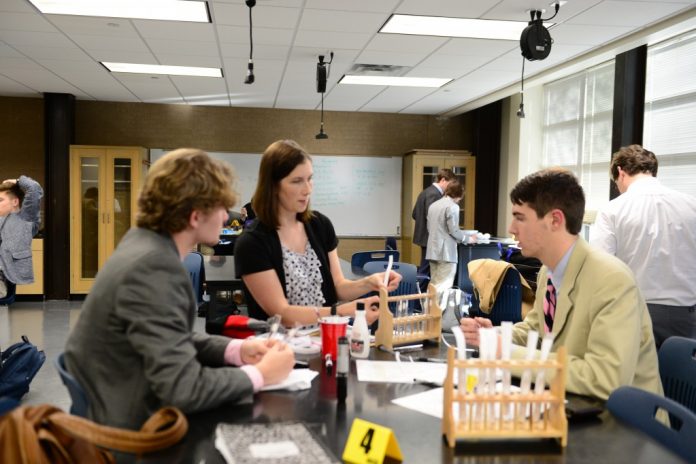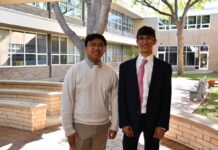Surrounded by hysteria, the police report to the crime scene, sirens blaring and flashing. At the scene lies a body, bruised and battered, blood splattered across the brick of the alleyway. Working like bees, forensic scientists surround the scene, investigating blood splatters, collecting fingerprints, and taking samples. These scientists play a pivotal role in discovering what happened at the scene, able to recreate what happened that night and even help find the criminal. Here at Jesuit, a forensics science course is offered as a semester class to offer insight into forensic science and the process used to discover how crimes took place. Though the course only takes a semester, the students learn plenty of skills which all come together in their assessment, the investigation of a murder.
In years past, forensic students were tasked with solving the murder of Mrs. Boyle through interrogation of teachers and crime scene investigation. Though they embarked on a thrilling adventure, the students were unable to utilize all of the skills they learned throughout the semester. In an attempt to remedy this, the forensics final underwent a change this year; rather than just be given a mystery to solve, the students were put in a lab environment and asked to a perform a series of tasks based on what they were taught this semester, skills such as DNA testing, ballistic analysis, and blood splatter analysis. Mrs. Boyle prefers this format because it allows students to work “hands on” with the lab equipment and directly apply their skills in a lab setting rather than be “given a sheet of paper” with all information relevant to the investigation. Despite the sudden change in format, Mrs. Boyle says that the students performed “great” given the circumstances and hopes to continue this new student-friendly format in the future.
The skills learned in the forensics course can be easily applied to real-world situations, making the information students learn in the class relevant in their lives beyond Jesuit. During the year, students researched and taught their classmates about specific sections of forensics, sections which ranged from blood splatter to ballistic analysis. These presentation skills can become relevant in college or in a professional setting when presenting projects and ideas, presentations which can be daunting to the inexperienced and last over half an hour. The students also learned proper interrogation skills through their questioning of teachers in the pursuit of data for their final. These skills can help in situations where one must interview or question a subject, situations which can occur in law enforcement, journalism, or in a court of law. Most importantly, forensics sharpens a student’s deductive reasoning through their investigation of data and test results. Playing a role in life regardless of one’s pursued career, deductive reasoning is heavily focused on throughout the course to aptly prepare students. Even if one doesn’t plan on pursuing forensics later in life, the skills learned in the course can help regardless of what direction a student plans on going.
Taking this course allows students to use their newly found knowledge of forensics in their lives. For example, while serving as a member of a jury, understanding the forensic information in the case can help one come to a better understanding of the crime, allowing for a more clear view of the case and helping achieve a proper verdict. However, forensics is not limited to the physical world; forensics extends even to cyber crime. In a society dominated by digital technology, cyber crimes are incredibly relevant to everyday life and are not something to be trifled with. Forensics can be applied to many aspects of our lives and can be far more relevant than one may assume. For those with even a remote interest in forensics, sign up for the class, you won’t regret it!






